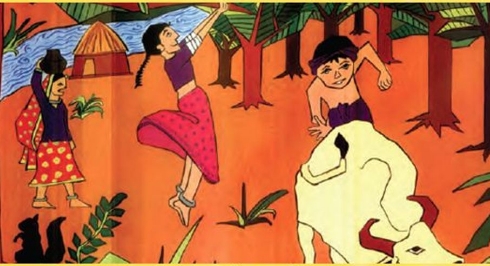
NCERT Solutions for Class 4 EVS Chapter 4: Students can learn about the value of trees and the reasons behind their conservation through The Story of Amrita. The narrative of Amrita's heroic efforts to save the trees is told in this chapter. Aside from that, there are some significant tasks and problems regarding trees and the associated ecology in NCERT Solutions Class 4 EVS Chapter 4.
Students will be able to investigate trees and the ecosystem and learn about its features, as well as the relationships between trees and other plants that support various organisms, with the aid of the solutions provided here. Furthermore, students can use these solutions as excellent references and exam preparation tools.NCERT Solutions for Class 4 EVS Chapter 4 Overview
NCERT Solutions for Class 4 EVS Chapter 4, "The Story of Amrita," narrates the life of a young girl named Amrita, who faces and overcomes various challenges with courage and determination. The chapter highlights themes of resilience, community support, and personal growth, illustrating how Amrita's experiences help her learn valuable life lessons. Through engaging stories and activities, the chapter aims to teach students about empathy, perseverance, and the importance of helping others, fostering a deeper understanding of these values in everyday life.The Story of Amrita
"The Story of Amrita" centers on environmental protection and the unbreakable bond between humans and trees. Amrita Devi Bishnoi, along with her villagers, risked their lives to save the trees in their village from being cut by the king’s men. The incident led to a royal decree protecting the area’s trees an early example of environmental activism that still inspires conservation efforts today.
The Story of Amrita Class 4 Question Answer
The story of Amrita is about a brave girl who lived in Khejadli village, Rajasthan, and loved trees deeply. When the king’s men came to cut the village trees for wood, Amrita hugged the trees to protect them and inspired her daughters and fellow villagers to do the same. Their sacrifice shocked the king, who then ordered that no more trees should be harmed in their area. This story teaches us the value of environmental conservation and the courage needed to stand up for nature.
Class 4th EVS Chapter 4 Question Answer
Class 4 EVS Chapter 4, "The Story of Amrita," includes questions about Amrita’s actions and the importance of her sacrifice. Students are asked to explain why Amrita protected the trees, what happened when the king’s men arrived, and how the villagers joined together to save their environment. Answers focus on the significance of teamwork, bravery, and the long-lasting impact of the Bishnoi community’s dedication to nature.
NCERT Solutions for Class 4 EVS Chapter 4 PDF
Here we have provided NCERT Solutions for Class 4 EVS Chapter 4 for the ease of children so that they can prepare better for their upcoming exams. These solutions will help them to understand the chapter in depth. Also, here we have attached a pdf so that students can access these solutions without internet.NCERT Solutions for Class 4 EVS Chapter 4 PDF
NCERT Solutions for Class 4 EVS Chapter 4
1. Is there a place near your house, school or along the roadside where trees have been planted?

Answer:
Yes, there is a park with trees planted not far from my house.2. Why were they planted there?
Answer:
They are planted there to produce fruits and shade, as well as to clean the surrounding air.3. Have you seen anyone taking care of the trees? Who does this?
Answer:
Yes, I saw a few people caring to the trees. There are four of them working in that park, and they go by the name of gardeners.4. Have you seen fruits on any of the trees? Who eats these fruits?
Answer:
Yes, I have seen guava and mango hanging from the trees. These are eaten by park caretakers, and certain birds also consume these fruits.5. Lalita feels that grass and small plants growing near her school wall have not been planted by anyone. Do you know of any place where grass, small plants or trees are growing on their own without being planted by anyone?
Answer:
Yes, grass, tiny plants, and trees are growing naturally—no one has planted them—on vacant lots, fields, and by the sides of roadways.6. Why do you feel they are growing on their own?
Answer:
As no one planted them, they grow on their own.Trees in Danger
1. Do you remember what the elders of this village used to say?
Answer:
Yes, I do remember. "Agar perh hain to hum hain," said the village elder in the past. This implies that although humans cannot exist without plants and animals, they can exist without humans.2. Do you think we could survive if there were no trees and no animals? Discuss this in your class.
Answer:
No, since they give us with food and oxygen to breathe, animals and trees are essential to human survival.The Village is Protected
Write about any one tree.
Mango tree1. Does the tree flower?
Answer:
Yes, the mango tree is a flowering plant.2. Do the flowers remain on the tree throughout the year?
Answer:
No, the flowers don't stay on the tree all year round.3. In which month do their leaves fall?
Answer:
Although the mango tree is an evergreen, its leaves typically fall in the middle of October or November during the dry winters and then reappear in the spring.4. Do fruits grow on the tree? Answer:
Yes, fruits do grow on a mango tree.5. In which months do they grow?
Answer:
The fruits of mango trees are grown from May to September.6. Have you eaten these fruits?
Answer:
Yes, I have eaten mangoes.Discuss
1. Why do people hunt?
Answer:
In addition to using, it for pleasure, people hunt animals for their flesh, skin, and bones.2. There are rules against the hunting of some animals. People can be punished for hunting. Why do you think there is this punishment?
Answer:
The purpose of punishment is to prevent hunting and protect animals.Talk to grandparents and find out –
3. Which birds did they see around them when they were of your age?
Answer:
Parrot, Pigeon, Eagle, peacock etc.4. Have the number of some of these birds become less?
Answer:
Yes, the number of sparrows, eagles and vultures has become less.5. Are there some birds or animals which they cannot see anymore?
Answer:
Yes, Great Indian Bustard and the cheetah are not seen anymore.Page: 37
1. Shanti’s grandfather told her that when he was a small child, he saw more birds like sparrows and mynah than he sees today. Can you make two guesses why their numbers have become less?
Answer:
The decrease in the population of these birds may be due to hunting and tree cutting.2. The Khejadi tree was the most common tree that grew in Amrita’s village. Which kind of trees can you see a lot of in your area? Name two such trees.
Find out more about these trees from your elders.
In my neighborhood, I saw a lot of teak and mango trees. Teak: The teak tree is a huge tree. It gives them access to fresh air and shade. The cost of teak wood is high. There is no fruit on the teak tree. Its wood is utilized to make furnishings. Mango: Although the mango tree is evergreen, its leaves typically fall in the middle of October or November during the dry winters and then reappear in the spring. Mangoes, one of their fruits, will be accessible from May through September. The delicious mango fruit is consumed raw, and the branches are utilized for fuel.Class 4 EVS Chapter 4 Extra Questions
Here are some sample questions and answers based on "The Story of Amrita" for Class 4 EVS Chapter 4:
Q1. Who was Amrita and where did she live?
Amrita was a brave girl who lived in Khejadli village in Rajasthan. She was known for her love and care for trees in her village.
Q2. Why did the people of Khejadli village consider trees special?
The people of Khejadli believed that trees were very important for a healthy environment. Trees provided them with clean air, shade, and homes for many animals and birds.
Q3. What did Amrita do when the king’s men came to cut the trees?
When the king’s men came to cut the trees, Amrita hugged a tree tightly and refused to let them cut it. Her bravery inspired other villagers to do the same, and they all tried to protect the trees together.
Q4. What lesson do we learn from the story of Amrita?
This story teaches us about the importance of trees and the courage to protect nature. It shows that one person’s actions can inspire an entire community to save the environment.
Q5. What did the king do after learning about the villagers’ sacrifice?
After seeing the villagers’ determination and sacrifice, the king ordered his men to stop cutting trees and promised to protect the trees and animals of Khejadli village.
Benefits of NCERT Solutions for Class 4 EVS Chapter 4
ICSE Class 9 Maths Selina Solutions for Chapter 18 on Statistics provide several key benefits for students, enhancing their understanding and proficiency in the subject. Here’s a concise overview:Conceptual Understanding
Clear Explanations: Solutions offer detailed, step-by-step explanations for statistical concepts such as mean, median, mode, and measures of dispersion. This helps in building a strong foundational understanding.
Visual Aids: The use of graphs and charts in the solutions aids in visualizing data, making it easier to grasp statistical concepts.
Enhanced Problem-Solving Skills
Diverse Problems: Exposure to various types of problems helps students practice different techniques for analyzing and interpreting statistical data.
Methodical Approach: Solutions demonstrate systematic methods to solve problems, reinforcing correct procedures and improving analytical skills.
Effective Exam Preparation
ICSE Syllabus Alignment: Solutions are aligned with the ICSE curriculum, ensuring students are well-prepared for their exams with relevant examples and question types.
Familiarity with Exam Patterns: Practicing with these solutions helps students become familiar with common exam questions and formats, aiding in better time management and exam performance.
Self-Study and Revision
Independent Learning: Provides a valuable resource for students to study and revise statistical concepts on their own, enhancing their ability to work independently.
Error Correction: Students can identify and correct mistakes by comparing their solutions with the provided ones, leading to improved accuracy and understanding.
Foundation for Advanced Topics
Building Blocks: Mastery of basic statistical concepts in Class 9 sets the stage for more complex topics in higher grades, making future learning more manageable.
Preparation for Higher Studies: A solid grasp of statistics is crucial for advanced mathematics and data-related subjects in higher education.
Related Links-
NCERT Solutions For Class 4 EVS Chapter 4 FAQs
Are NCERT Solutions for Class 4 EVS Chapter 4 useful?
Where can I find the NCERT Solutions for Class 4 EVS Chapter 4 PDF?
What is the moral of the Amrita story?
Is the story of Amrita based on a true story?
Why were they planted trees?










